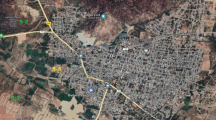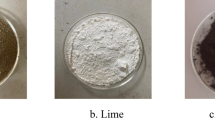Abstract
Recycled waste materials have been investigated in different ways in civil engineering applications and at these studies the usability of waste materials have been examined in concrete production, road construction and soil improvement. In this study, the effect of recycled nano carbon black (nano-CBr) on consistency limits and unconfined compressive strength properties of clayey soils was investigated. For this purpose, 4 different ratios (1%, 3%, 5% and 10%) nano-CBr were mixed to 3 different clay soils (White, Green and Red clays). In order to determine the mineralogical and chemical properties of mixtures, pH, TDS, X-Ray, SEM and contact angle tests were also performed. In this study, 1% nano-CBr ratio was generally determined as the limit value in all experiments. The consistency properties of the mixed samples have not significantly changed for the red and green clay but have importantly affected the white clay properties. Based on the 1% nano-CBr ratio, the unconfined compressive strength (UCS) values of all mixed samples increased. Addition of super hydrophobic nano-CBr to clay soils, turned clay soils into a hydrophobic material, is resulting in an increase in the contact angle values. On the other hand, pH values did not show a significant change with the increase of the nano-CBr ratio. The total dissolved solids (TDS) measurements showed a series of rise and fall steps with the increase of nano-CBr ratio and showed a tendency to stabilize at 10% nano-CBr ratio.











Similar content being viewed by others
References
Pedro D, De Brito J and Evangelista L 2014 Influence of the use of recycled concrete aggregates from different sources on structural concrete. Constr. Build. Mater. 71: 141–151
Duan Z H and Poon C S 2014 Properties of recycled aggregate concrete made with recycled aggregates with different amounts of old adhered mortars. Mater. Des. 58: 19-29
Silva R V, De Brito J and Dhir R K 2016 Establishing a relationship between modulus of elasticity and compressive strength of recycled aggregate concrete. J. Clean. Prod. 112: 2171–2186
Letelier V, Tarela E, Muñoz P and Moriconi G 2017 Combined effects of recycled hydrated cement and recycled aggregates on the mechanical properties of concrete. Constr. Build. Mater. 132: 365–375
Ismail S, Kwan W H and Ramli M 2017 Mechanical strength and durability properties of concrete containing treated recycled concrete aggregates under different curing conditions. Constr. Build. Mater. 155: 296–306
Gupta C and Sharma R K 2014 Influence of micro silica fume on sub grade characteristics of expansive soil. Int. J. Civ. Eng. Res. 5: 77–82
Disfani M M, Arulrajah A, Bo M W and Sivakugan N 2012 Environmental risks of using recycled crushed glass in road applications. J. Clean. Prod. 20: 170–179
Kampala A, Horpibulsuk S, Chinkullijniwat A and Shen S L 2013 Engineering properties of recycled calcium carbide residue stabilized clay as fill and pavement materials. Constr. Build. Mater. 46: 203–210
Arulrajah A, Piratheepan J, Disfani M M and Bo M W 2012 Geotechnical and geoenvironmental properties of recycled construction and demolition materials in pavement subbase applications. J. Mater. Civ. Eng. 25: 1077–1088
Hoy M, Horpibulsuk S, Rachan R, Chinkulkijniwat A and Arulrajah A 2016 Recycled asphalt pavement–fly ash geopolymers as a sustainable pavement base material: Strength and toxic leaching investigations. Sci. Total Environ. 573: 19–26
Ojum C and Thom N 2017 Effect of binder in recycled asphalt on cold-mix pavements. Proc. Inst. Civ. Eng. Constr. Mater. 170: 205–210
Tulek M 2007 A Study of the Use of Chemical Waste Gypsums in Soil Stabilization. Master Thesis, Balikesir University, Balıkesir, Turkey
Coruh E, Hinisoglu S, Kocakerim M, Arasan S and Oltulu M 2013 Investigation of the usage of borogypsum in the subbase course as a stabilization material. EÜFBED Grad. Sch. Nat. Appl. Sci. J. 6: 221–231
[14] Kütük-Sert T and Kütük S 2012 Physical and marshall properties of borogypsum used as filler aggregate in asphalt concrete. J. Mater. Civ. Eng. 25: 266–273
Shen W, Zhou M and Zhao Q 2007 Study on lime–fly ash–phosphogypsum binder. Constr. Build. Mater. 21: 1480–1485
Yilmaz I and Civelekoglu B 2009 Gypsum: an additive for stabilization of swelling clay soils. Appl. Clay Sci. 44: 166–172
Shen W, Zhou M, Ma W, Hu J and Cai Z 2009 Investigation on the application of steel slag–fly ash–phosphogypsum solidified material as road base material. J. Hazard. Mater. 164: 99–104
Kalantari B, Prasad A and Huat B B 2011 Stabilising peat soil with cement and silica fume. Proc. Inst. Civ. Eng. Geotech. Eng. 164: 33–39
Sattar M A A, Daud K A and Al-Azzawi A A 2012 Effect of silica fume addition on the behavior of silty-clayey soils. J. Eng. Sustain. Dev. 16: 92–105
Negi C, Yadav R K and Singhai A K 2013 Effect of silica fume on index properties of black cotton soil. Int. J. Sci. Eng. Res. 4: 828-833
Edil T B, Acosta H A and Benson C H 2006 Stabilizing soft fine-grained soils with fly ash. J. Mater. Civ. Eng. 18: 283–294
Chauhan M S, Mittal S and Mohanty B 2008 Performance evaluation of silty sand subgrade reinforced with fly ash and fiber. Geotext. Geomembr. 26: 429–435
Brooks R M 2009 Soil stabilization with fly ash and rice husk ash. Int. J. Res. Rev. Appl. Sci. 1: 209–217
Isık F and Akbulut R K 2018 Effect of recycled carbon black on consistency limits of clayey soils. Iğdır Univ. J. Inst. Sci. Technol. 8: 123–130
Edil T B and Bosscher P J 1994 Engineering properties of tire chips and soil mixtures. Geotech. Test. J. 17: 453–464
Masad E, Taha R, Ho C and Papagiannakis T 1996 Engineering properties of tire/soil mixtures as a lightweight fill material. Geotech. Test. J. 19: 297–304
Edinçliler A, Baykal G and Saygılı A 2010 Influence of different processing techniques on the mechanical properties of used tires in embankment construction. Waste Manag. 30: 1073–1080
Sheikh M, Mashiri M S, Vinod J S and Tsang H H 2013 Shear and compressibility behavior of sand–tire crumb mixtures. J. Mater. Civ. Eng. 25: 1366–1374
Brunet S, De La Llera J C and Kausel E 2016 Non-linear modeling of seismic isolation systems made of recycled tire-rubber. Soil Dyn. Earthq. Eng. 85: 134–145
BS 1377 Part 2 1990 Methods of Test for Soils for Civil Engineering Purposes. Classification tests. British Standards Institution
ASTM D 4318-00 2000 Standard Test Method for Liquid Limit, Plastic Limit, and Plasticity Index of Soils. ASTM International, West Conshohocken, PA, USA
ASTM D 2166 1991 Standard Test Method for Unconfined Compressive Strength of Cohesive Soil. ASTM International, West Conshohocken, PA, USA
Gürses A and Bayrakçeken S 1996 The empirical physicochemistry (in Turkish) Erzurum Turkey. Ataturk Univ. Pap. 807: 59–65
Zhang C, Liu Z and Deng P 2016 Contact angle of soil minerals: A molecular dynamics study. Comput. Geotech. 75: 48–56
Fredlund D G and Rahardjo H 1993 Soil Mechanics for Unsaturated Soils. Wiley, Hoboken
Lu N and Likos W J 2004 Unsaturated Soil Mechanics. Wiley, Hoboken
Liu Z, Yu X and Wan L 2016 Capillary rise method for the measurement of the contact angle of soils. Acta Geotech. 11: 21–35
Duriez J and Wan R 2017 Contact angle mechanical influence in wet granular soils. Acta Geotech. 12: 67–83
Manahiloh K N and Meehan C L 2017 Determining the soil water characteristic curve and interfacial contact angle from microstructural analysis of X-ray CT images. J. Geotech. Geoenviron. Eng. 143: 04017034
Akbulut R K 2008 Some Physical and Chemical Properties of Clay Treated with Surfactant. Master Thesis, Ataturk University, Erzurum, Turkey
Skoog D A, West D M, Holler F J and Crouch S 2013 Fundamentals of Analytical Chemistry, 9th edn. Nelson Education, Toronto
ASTM D 4972-01 2001 Standard Test Methods for pH of Soils. ASTM International, West Conshohocken, PA, USA
Sridharan A, El-Shafei A and Miura N 2002 Mechanisms controlling the undrained strength behavior of remolded Ariake marine clays. Mar. Georesour. Geotechnol. 20: 21–50
Schmitz R M, Schroeder C and Charlier R 2004 Chemo–mechanical interactions in clay: a correlation between clay mineralogy and Atterberg limits. Appl. Clay Sci. 26: 351–358
Park J, Vipulanandan C, Kim J W and Oh M H 2006 Effects of surfactants and electrolyte solutions on the properties of soil. Environ. Geol. 49: 977–989
Arasan S and Yetimoglu T 2008 Effect of inorganic salt solutions on the consistency limits of two clays. Turk. J. Eng. Environ. Sci. 32: 107–115
Zaimoglu A S, Tan O and Akbulut R K 2016 Optimization of consistency limits and plasticity index of fine-grained soils modified with polypropylene fibers and additive materials. KSCE J. Civ. Eng. 20: 662–669
Al-Khanbashi A and Abdallah S W 2006 Evaluation of three waterborne polymers as stabilizers for sandy soil. Geotech. Geol. Eng. 24: 1603–1625
Ateş A 2013 The effect of polymer-cement stabilization on the unconfined compressive strength of liquefiable soils. Int. J. Polym. Sci. https://doi.org/10.1155/2013/356214
Arasan S and Nasirpur O 2015 The effects of polymers and fly ash on unconfined compressive strength and freeze-thaw behavior of loose saturated sand. Geomech. Eng. 8: 361–375
Arasan S, Bagherinia M, Akbulut R K and Zaimoglu A S 2017 Utilization of polymers to improve soft clayey soils using the deep mixing method. Environ. Eng. Geosci. 23: 1–12
Cabuk N 2012 Synthesis of Superhydrophobic Nanocoatings by Using Hot Filament Chemical Vapor Deposition Method. Master Thesis, Selcuk University, Konya, Turkey
Piper C S 1942 Soil and Plant Analysis. University of Adelaide, Adelaide
Rayment G E and Higginson F R 1992 Australian Laboratory Handbook of Soil and Water Chemical Methods. Inkata Press Pty Ltd, Melbourne
Author information
Authors and Affiliations
Corresponding author
Rights and permissions
About this article
Cite this article
Akbulut, R.K., Isik, F. Investigation of geotechnical properties of clay soils mixed with recycled nano carbon black. Sādhanā 46, 49 (2021). https://doi.org/10.1007/s12046-021-01569-5
Received:
Revised:
Accepted:
Published:
DOI: https://doi.org/10.1007/s12046-021-01569-5




